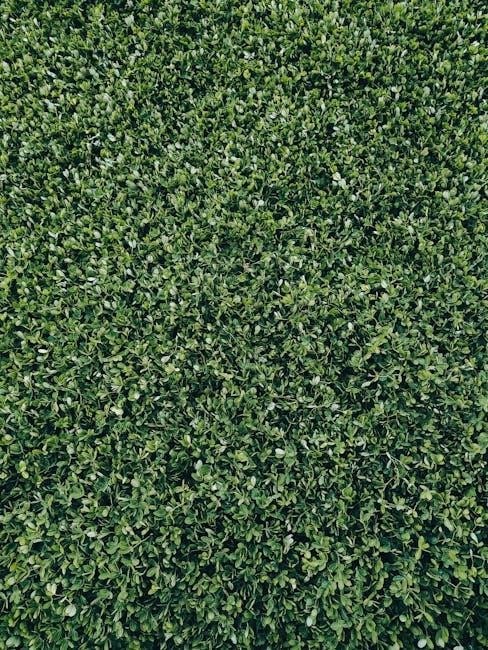zone 7a planting guide
Zone 7a offers a moderate climate with cold winters and warm summers, perfect for diverse gardening. This guide helps gardeners maximize yields and minimize losses by understanding the zone’s unique conditions and optimal planting times.
1.1 Understanding USDA Hardiness Zones
The USDA Hardiness Zones are a guide to determine which plants can survive in specific areas based on average annual extreme minimum temperatures; Divided into 11 zones, each representing a 10-degree Fahrenheit range, they help gardeners choose plants suited to their region. Zone 7a, for example, has temperatures ranging from 0 to 5 degrees Fahrenheit. This system is crucial for selecting plants that can thrive in local climate conditions, ensuring gardeners avoid species that may not survive winter or summer extremes. Understanding your zone is the first step in successful gardening, as it guides planting times and plant selection.
1.2 Climate and Growing Season in Zone 7a
Zone 7a experiences a temperate climate with cold winters and warm summers. The average annual extreme minimum temperature ranges from 0°F to 5°F, allowing for a relatively long growing season. Typically, the last spring frost occurs around late March to early April, while the first fall frost happens in late September to early October. This creates a growing season of approximately 220 days. Gardeners in Zone 7a enjoy four distinct seasons, with cool springs, warm summers, mild autumns, and chilly winters. Understanding these patterns helps in selecting plants that thrive in these conditions and timing plantings to avoid frost damage.
1.3 Importance of Knowing Your Planting Zone
Understanding your USDA Hardiness Zone is essential for successful gardening. It provides critical insights into the average temperature extremes your area experiences, helping you choose plants that can thrive in local conditions. Knowing your zone ensures you plant at the right time, avoiding frost damage and optimizing growth. This knowledge also helps in selecting varieties with appropriate maturity dates, maximizing yields, and reducing the risk of crop failure. The USDA zone system serves as a reliable guide for gardeners to make informed decisions tailored to their specific climate, ensuring a more productive and enjoyable gardening experience.
Key Considerations for Planting in Zone 7a
Zone 7a’s moderate climate requires careful planning, focusing on frost dates, soil health, and plant selection to ensure optimal growth and productivity throughout the growing season.
2.1 Average Frost Dates and Growing Season
In Zone 7a, the average last spring frost occurs around April 15, while the first fall frost is typically October 15. This provides a moderate growing season of approximately 180–210 days. Knowing these dates is crucial for timing plantings correctly. Vegetables and flowers should be planted after the last frost to avoid damage. Similarly, fall crops need to mature before the first frost. Understanding these frost dates helps gardeners plan effectively, ensuring optimal growth and harvest. This information is essential for selecting varieties with appropriate maturity rates and for extending the growing season using techniques like cold frames or row covers.
2.2 Soil Preparation for Zone 7a
Soil preparation is vital for a thriving garden in Zone 7a. Test your soil to determine its pH level and nutrient content, as most plants prefer a slightly acidic to neutral soil pH (6.0–7.0). Add organic matter like compost or well-rotted manure to improve soil structure and fertility. Zone 7a soils often benefit from drainage enhancements, especially in heavier clay areas. Till the soil to a depth of 8–12 inches to loosen and aerate it. Incorporate balanced fertilizers based on soil test results to ensure optimal nutrient availability. Proper soil preparation in early spring or fall sets the foundation for healthy plant growth throughout the growing season.
2.3 Choosing the Right Plants for Zone 7a
Selecting plants suited to Zone 7a is crucial for a successful garden. Opt for varieties that thrive in its moderate climate, with cold winters and warm summers. Vegetables like tomatoes, peppers, and cucumbers excel in the zone’s warm seasons, while cool-season crops such as broccoli and kale perform well in spring and fall. Consider plants with medium to high frost tolerance, as Zone 7a experiences occasional light frosts. Choose varieties with maturity dates that align with the zone’s growing season, typically around 180–200 days. Always check the specific planting requirements for each variety to ensure optimal growth and productivity in Zone 7a’s conditions.

Spring Planting Guide for Zone 7a
Zone 7a’s moderate climate allows for a wide variety of spring crops. Start with cool-season plants like spinach and lettuce in early spring, transitioning to warm-season crops after the last frost.
3.1 Early Spring Crops (February-March)
In Zone 7a, early spring planting begins in late winter to early spring, typically 4-6 weeks before the last frost. Cool-season crops like spinach, lettuce, radishes, peas, and onions thrive during this period. These crops prefer cooler temperatures and can tolerate light frosts. Plant seeds directly in well-prepared soil, loosened to a depth of 8-10 inches for root vegetables. Add compost or well-rotted manure to improve soil fertility. Keep the soil consistently moist but not waterlogged. For some crops, like broccoli or kale, consider starting indoors 4-6 weeks before the last frost and transplanting outside. Early spring is also ideal for planting asparagus and strawberry crowns. Use row covers to protect young plants from sudden frosts, ensuring a robust start to the growing season.
3.2 Mid-Spring Crops (April-May)
In Zone 7a, mid-spring (April-May) is ideal for planting warm-season crops as the soil warms and frost risks diminish. Popular choices include tomatoes, peppers, cucumbers, zucchini, and squash. Direct sow beans, corn, and carrots after the last frost. For tomatoes and peppers, start seedlings indoors 4-6 weeks earlier and transplant in late April. Soil temperature should reach 60°F for optimal germination. Add compost to improve soil fertility and drainage. Proper spacing and full sun (6+ hours daily) are essential for healthy growth. Keep the soil consistently moist but not waterlogged to promote robust development.
3.3 Late Spring Crops (May-June)
In Zone 7a, late spring (May-June) is prime for planting warm-season crops as temperatures rise. Tomatoes, peppers, eggplants, and squash thrive when soil warms to 70°F. Start seedlings indoors 4-6 weeks prior for earlier yields. Direct sow green beans, corn, and okra in late May. Zucchini and cucumbers also excel in this period. Ensure full sun (6+ hours) and well-draining soil. Proper spacing prevents overcrowding, while consistent moisture promotes healthy growth. Mulch around plants to retain heat and suppress weeds. These crops benefit from warmer days, making late spring an ideal time for abundant harvests in Zone 7a gardens.

Summer Planting Guide for Zone 7a
Zone 7a’s summer offers ideal conditions for warm-season crops like tomatoes, peppers, and eggplants. Plant heat-tolerant varieties in well-draining soil when temperatures rise for optimal growth and productivity.
4.1 Warm-Season Crops (June-July)
Warm-season crops thrive in Zone 7a during June and July, when temperatures are consistently high. Popular choices include tomatoes, peppers, eggplants, and okra. These crops prefer well-draining soil and full sun. Plant seeds or seedlings after the last frost date to ensure optimal growth. Tomatoes and peppers can be started indoors 4-6 weeks before the last frost and transplanted outside. Okra and southern peas are direct-sown in late spring or early summer. Regular watering and mulching help retain moisture and suppress weeds. Fertilize lightly at planting and again during the growing season for maximum productivity. Proper spacing allows for air circulation, reducing disease risks. With proper care, these crops will yield abundant harvests throughout the summer months.
4.2 Heat-Tolerant Vegetables
Zone 7a’s warm summers are ideal for growing heat-tolerant vegetables like tomatoes, peppers, eggplants, and okra. These crops thrive in high temperatures and well-draining soil. Tomatoes and peppers can be started indoors 4-6 weeks before the last frost date and transplanted outside. Okra and southern peas are direct-sown in late spring or early summer. Mulching helps retain moisture and suppress weeds, while regular watering ensures consistent growth. Fertilize lightly at planting and mid-season for optimal yields. Proper spacing between plants improves air circulation, reducing disease risks. These vegetables are perfect for Zone 7a’s long, warm growing season.
4.3 Summer Soil Care and Maintenance
Proper soil care is essential during Zone 7a’s warm summers. Mulch around plants to retain moisture, suppress weeds, and regulate soil temperature. Water deeply but avoid overwatering, which can lead to root rot. Use compost or balanced fertilizers to maintain soil fertility and promote healthy plant growth. Monitor soil pH levels, as extreme heat can affect nutrient availability. Regularly inspect soil for signs of dehydration or nutrient depletion. Incorporate organic matter to improve soil structure and drainage. Proper summer soil care ensures plants remain resilient and productive throughout the growing season in Zone 7a.

Fall Planting Guide for Zone 7a
Zone 7a’s fall season offers ideal conditions for cool-season crops like broccoli, kale, and carrots. Plant in late summer to early fall, allowing crops to mature before the first frost. Soil preparation is key, with compost additions to enrich the ground. Timing planting according to frost dates ensures a successful harvest. Proper planning and crop rotation maximize the fall gardening experience in Zone 7a.
5.1 Cool-Season Crops (August-September)
Zone 7a gardeners can enjoy a bounty of cool-season crops during August and September. These crops thrive in the cooler temperatures of late summer and early fall. Popular choices include broccoli, kale, spinach, carrots, beets, and lettuce. Plant these vegetables 8-10 weeks before the first expected frost to ensure proper maturation. Start seeds indoors for transplants or direct sow in well-prepared soil. Enrich the soil with compost to promote healthy growth. Proper spacing and consistent watering are essential for optimal yields. These crops are perfect for extending the growing season and providing fresh produce well into the fall months in Zone 7a.
5.2 Preparing for Fall Frost
Preparing for fall frost in Zone 7a is crucial to protect plants and soil. The average first fall frost occurs around October 15th. Gardeners should clear the garden of dead or dying plants to prevent disease. Add compost or mulch to enrich the soil for next year. Sensitive plants can be protected with frost blankets or brought indoors. Hardy perennials should be cut back, and tender bulbs like dahlias should be dug up and stored. Clean and store garden tools, and plan for next year’s garden; Proper preparation ensures a healthy start for the following growing season in Zone 7a.
5.3 Extending the Growing Season
To extend the growing season in Zone 7a, gardeners can utilize techniques like succession planting and cold frames. Row covers protect crops from early frosts, while hoop houses and greenhouses provide longer growing periods. Planting cool-season crops in late summer ensures a fall harvest. Selecting varieties with shorter maturation periods also helps maximize yields. Additionally, mulching around plants retains soil warmth, and bringing sensitive plants indoors during frosts can prolong their productivity. These strategies allow gardeners to enjoy a longer and more productive growing season in Zone 7a, even as temperatures begin to drop.

Winter Planting Guide for Zone 7a
Zone 7a’s moderate winters allow for planting cold-hardy vegetables like kale and spinach. Use techniques like mulching and hoop houses to protect plants and extend productivity during colder months.
6.1 Cold-Hardy Vegetables
Cold-hardy vegetables thrive in Zone 7a’s moderate winters. Kale, spinach, Brussels sprouts, and broccoli are excellent choices, tolerating light frosts and cooler temperatures. Root vegetables like carrots and beets also perform well. Plant these in late summer or early fall, about 8 weeks before the first frost, to allow them to mature. Mulching and hoop houses can extend the growing season, protecting plants from harsher cold snaps. These vegetables not only survive but often sweeten in flavor after exposure to frost. Proper soil preparation and timing ensure a bountiful winter harvest in Zone 7a’s climate.
6.2 Winter Soil Protection
Protecting soil during Zone 7a’s winter is crucial for maintaining fertility and structure. Apply a thick layer of organic mulch, such as straw or wood chips, to insulate the ground and prevent erosion. Incorporating compost or well-rotted manure before winter enriches the soil and improves its drainage. Cover crops like clover or rye can be planted in fall to protect the soil and add nutrients upon spring tilling. Avoid leaving soil bare, as cold temperatures and moisture can degrade its quality. Proper winter care ensures a healthy, productive garden come spring.
6.3 Planning for Next Year’s Garden
Planning for next year’s garden in Zone 7a begins with reviewing the previous season’s successes and challenges. Assess soil health and amend as needed based on winter protection efforts. Order seeds and supplies early to ensure availability. Create a detailed planting schedule, considering frost dates and crop rotations. Research new varieties or techniques to incorporate. Stay flexible to adapt to weather changes. Proper planning ensures a head start and maximizes the growing season’s potential, helping you achieve a thriving and productive garden year after year.
Vegetable-Specific Planting Tips
This section provides tailored advice for growing popular vegetables in Zone 7a, ensuring optimal timing, soil preparation, and care for a bountiful harvest.
7.1 Leafy Greens and Brassicas
Leafy greens like kale, spinach, and lettuce thrive in Zone 7a’s cooler seasons. Plant them in early spring or late summer for a fall harvest. Brassicas, such as broccoli and cauliflower, prefer the same seasons. Sow seeds 4-6 weeks before the first frost for a robust fall crop. Ensure soil is well-draining and rich in organic matter, with a pH between 6.0-7.0. Consistent moisture and partial shade promote healthy growth. Mulch around plants to retain moisture and suppress weeds. Zone 7a’s moderate climate allows for multiple harvests, making these crops ideal for year-round production with proper planning and care.
7.2 Root Vegetables
Root vegetables such as carrots, beets, radishes, and turnips excel in Zone 7a’s moderate climate. Plant them in early spring or late summer for a fall harvest. Ensure soil is loose, well-draining, and free of debris to prevent forking. Sow seeds directly into the ground, as transplants can disrupt root development. For optimal growth, maintain consistent moisture and provide full sun. Avoid over-fertilizing, especially with nitrogen, which can lead to excessive foliage growth. Thin seedlings appropriately to allow proper root expansion. Zone 7a’s cool winters and warm summers make it ideal for growing a variety of root vegetables, ensuring fresh produce throughout the growing season.
7.3 Fruiting Vegetables
Fruiting vegetables like tomatoes, peppers, eggplants, and cucumbers thrive in Zone 7a’s warm summers. Start seeds indoors 4-6 weeks before the last frost date for a head start. Plant them outside when soil warms to at least 60°F; Choose varieties with shorter maturation periods to maximize yields. Soil should be well-draining and rich in organic matter, with full sun exposure. Fertilize lightly at planting and again during flowering. Keep the area consistently moist but avoid overwatering, which can lead to disease. Proper spacing and support, such as cages or trellises, ensure healthy growth and fruit production.

Flower and Ornamental Planting Guide
Zone 7a’s moderate climate supports vibrant flowers and ornamentals year-round. Plant spring-blooming bulbs in fall, summer flowers after the last frost, and fall blooms by late summer for continuous color and beauty.
8.1 Spring-Blooming Flowers
Zone 7a’s spring offers ideal conditions for vibrant blooms. Plant bulbs like daffodils and tulips in fall for early spring color. Cool-season annuals such as pansies and violas thrive in Zone 7a’s mild springs. Perennials like peonies and irises bloom beautifully after winter. Ensure proper soil preparation and sunlight exposure for optimal growth. Deadheading encourages more blooms, while mulching retains moisture and suppresses weeds. Spring-blooming flowers add color and vibrancy to gardens, making Zone 7a perfect for growing a wide variety of flowering plants. Plan carefully to enjoy a stunning display from late winter to early summer. This guide helps you choose the best flowers for your Zone 7a garden.
8.2 Summer-Blooming Flowers
Zone 7a’s warm summers are ideal for vibrant summer-blooming flowers. Black-Eyed Susans, Lantana, and Zinnias thrive in the heat and bloom from mid-summer to fall. Plant these flowers in well-drained soil and full sun for optimal growth. Deadheading spent blooms encourages continuous flowering. Fertilize monthly to maintain vigor. Heat-tolerant perennials like Coneflowers and Daylilies also excel in Zone 7a’s climate. These flowers add color and life to gardens during the warmer months. Proper care ensures a stunning display of blooms throughout the summer season. Choose varieties that suit your garden’s specific conditions for the best results. This guide helps you select and care for summer-blooming flowers in Zone 7a.
8.3 Fall and Winter Blooms
Fall and winter blooms add beauty to Zone 7a gardens during cooler months. Pansies, violas, and snapdragons thrive in fall, while camellias and winter heather bloom in late winter. Plant fall-blooming flowers like asters and sedum in early summer for vibrant autumn color. For winter interest, plant bulbs like daffodils and tulips in fall, as they bloom in late winter. Protect sensitive plants from harsh winds and frost with mulch or covers. Choose varieties suited to Zone 7a’s cold temperatures, ensuring a stunning display of color year-round. Proper care extends the blooming season, even in colder months.

Monthly Planting Calendar for Zone 7a
This calendar outlines optimal planting times for Zone 7a, guiding gardeners through seasonal changes. Each month highlights specific crops, ensuring a thriving garden year-round.
9.1 January Planting Tips
In Zone 7a, January is a time for planning and preparation rather than active planting. Review last year’s garden performance and plan for the upcoming season. Order seeds and supplies early to ensure availability. Prune dormant shrubs and fruit trees to promote healthy growth. Protect winter crops like spinach and kale from extreme cold using row covers. Start seeds indoors for early spring crops, such as broccoli and cabbage, 8-10 weeks before the last frost date. January is also ideal for amending soil with compost or manure to prepare for the growing season ahead.
9.2 February Planting Tips
In Zone 7a, February marks the beginning of early spring preparations. Start seeds indoors for cool-season crops like broccoli, kale, and spinach, 6-8 weeks before the last frost date. Directly sow radishes, lettuce, and peas in late February if the soil is workable. Prune fruit trees and bushes while they are dormant to encourage healthy growth. Apply compost or well-rotted manure to soil to improve fertility. Monitor winter crops like Brussels sprouts and cabbage, protecting them from harsh weather. Plan your garden layout and order seeds or seedlings for the upcoming season; February is also a good time to mulch around perennials to retain moisture and suppress weeds.
9.3 March Planting Tips
In Zone 7a, March is an ideal time to transition into spring planting. Begin by direct-sowing cool-season crops like carrots, beets, and Swiss chard as soon as the soil thaws. Plant onion sets and potatoes in early March for a summer harvest. Start seedlings for warm-season crops such as tomatoes and peppers indoors, 4-6 weeks before the last frost date. Divide and replant perennials like asparagus and rhubarb. Apply pre-emergent herbicides to prevent weeds. Fertilize berry bushes and roses to promote healthy growth. Keep an eye out for early blooms and protect sensitive plants from late frosts with row covers or mulch.
9.4 April Planting Tips
In Zone 7a, April signals the start of the warm-season gardening cycle. Direct sow beans, cucumbers, and squash after the last frost date, typically mid-April. Transplant seedlings like tomatoes and peppers into well-prepared beds. Warm the soil with black plastic or mulch before planting heat-loving crops. Divide and replant summer-blooming perennials like daylilies and coneflowers. Fertilize lawns and apply pre-emergent weed control. Prune shrubs and roses to encourage new growth. Thin seedlings of early-spring crops like carrots and beets to allow proper spacing. Keep the garden consistently watered as the weather warms up, and control weeds before they spread.
9.5 May Planting Tips
In Zone 7a, May is ideal for planting warm-season crops. Direct sow tomatoes, peppers, and eggplants after the soil has warmed. Transplant seedlings like zucchini, okra, and cucumbers into well-draining soil. Sow seeds for corn, pumpkins, and squash, ensuring adequate spacing. Mulch around plants to retain moisture and suppress weeds. Fertilize lawns with a balanced fertilizer to promote healthy growth. Deadhead spring flowers to encourage more blooms. Prune spring-blooming shrubs after they finish flowering. Train climbing plants like peas and beans onto trellises or stakes. Keep an eye out for pests like aphids and caterpillars, treating them early to prevent damage.
9.6 June Planting Tips
In Zone 7a, June is ideal for planting heat-tolerant crops like okra, southern peas, and sweet potatoes. Direct sow seeds for summer squash, pumpkins, and watermelon in well-draining soil. Transplant heat-loving plants like eggplant and peppers into larger containers or directly into the garden. Mulch heavily to retain soil moisture and suppress weeds. Water deeply but infrequently to encourage deep root growth. Fertilize tomatoes and other fruiting plants with a high-phosphorus fertilizer to promote fruit production. Train vining plants like cucumbers and melons onto trellises or fences. Keep an eye out for common summer pests like aphids, hornworms, and squash bugs, treating them promptly to prevent damage.
9.7 July Planting Tips
July in Zone 7a is hot and humid, making it ideal for heat-tolerant crops. Continue planting okra, southern peas, and sweet potatoes. Sow seeds for heat-loving vegetables like eggplant, peppers, and tomatoes if using disease-resistant varieties. Mulch heavily to retain soil moisture and suppress weeds. Water deeply but avoid overwatering, which can lead to fungal diseases. Fertilize fruiting plants like tomatoes and peppers with a balanced fertilizer to promote continued production. Train vining plants like cucumbers and squash onto trellises. Monitor for pests like aphids, whiteflies, and hornworms, treating promptly with organic or chemical controls as needed to protect your harvest.
9.8 August Planting Tips
August in Zone 7a marks the transition from summer to fall. Focus on planting cool-season crops like broccoli, cauliflower, and kale for an early fall harvest. Sow spinach and lettuce seeds directly in shaded areas to avoid bolting. Consider starting seeds indoors for Brussels sprouts and cabbage. Soil preparation is key—add compost or well-rotted manure to replenish nutrients. Water deeply but avoid overwatering, as the heat can still be intense. Monitor for pests like aphids and caterpillars, using organic pest control methods. Divide and replant perennials, and deadhead flowers to encourage blooming. Prune shrubs to maintain shape and promote healthy growth.
9.9 September Planting Tips
In Zone 7a, September is ideal for planting cool-season crops like spinach, lettuce, and radishes. Start garlic cloves for a summer harvest. Divide and replant perennials, ensuring healthy growth. Add compost or manure to improve soil health for fall crops. Deadhead flowers to encourage late blooms. Clean up the garden to prevent disease and pests. Plan for next year by ordering bulbs and mapping layouts. With about 45 days until the first frost, choose varieties maturing quickly. Water consistently, especially for newly planted crops. Monitor for pests like aphids and caterpillars, using organic control methods. Prune shrubs to maintain shape and promote healthy growth.
9.10 October Planting Tips
In Zone 7a, October is a great time to plant garlic and shallots for a summer harvest. Sow spinach, kale, and radishes for a fall crop. Plant pansies and violas for colorful blooms. Divide and replant perennials like daylilies and hostas. Apply a layer of mulch to protect soil from cooling. Clean up fallen leaves and debris to prevent disease. Plant spring-blooming bulbs like daffodils and tulips. Protect sensitive plants from early frosts, expected in mid-October. Water plants deeply before the first frost to ensure soil moisture. Monitor for pests like slugs and snails in cooler, damper conditions.
9.11 November Planting Tips
In Zone 7a, November is ideal for planting cool-season crops like spinach, kale, and Brussels sprouts. Kale benefits from light frosts, enhancing its flavor. Plant garlic cloves for a summer harvest. Sow cover crops such as clover or rye to protect soil over winter. Apply compost or aged manure to enrich soil for next year. Mulch beds heavily to retain moisture and regulate soil temperature. Clean up garden beds by removing dead plants to prevent disease. Protect tender perennials with burlap or straw. Water evergreen plants deeply before ground freezes. November is also a good time to plan and order seeds for the upcoming gardening year.
9.12 December Planting Tips
In Zone 7a, December is a time to focus on winter gardening and preparation for the next growing season. Plant cold-hardy vegetables like spinach, kale, and Brussels sprouts, which thrive in cooler temperatures. Apply a protective layer of mulch or straw around sensitive plants to shield them from harsh winter conditions. Check soil moisture before the ground freezes to ensure it remains hydrated. Protect evergreen plants with burlap or anti-desiccant sprays to prevent winter damage. Review your garden’s performance from the past year and plan for improvements. Order seeds or bulbs for early spring planting. Clean and store gardening tools for the winter. This is also a great time to prune dormant shrubs and trees to promote healthy growth in the upcoming season. Properly insulate irrigation systems to prevent freezing. Keep an eye out for winter pests like rodents and deer that may target your plants. Finally, enjoy the quiet of the winter garden and reflect on the successes and challenges of the past year to refine your strategies for the next growing cycle.
